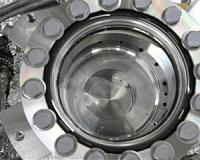 |
Paris (AFP) July 11, 2010 The European spacecraft Rosetta performed a fly-by of a massive asteroid on Saturday, the European Space Agency said, taking images that could one day help Earth defend itself from destruction. Racing through the asteroid belt between Mars and Jupiter at 47,800 kph (29,925 mph), the billion-euro (1.25-billion-dollar) probe flew within 3,200 kms (2,000 miles) of the huge potato-shaped rock, Lutetia. "The fly-by has been a spectacular success with Rosetta performing fautlessly," ESA said in a statement. "Just 24 hours ago, Lutetia was a distant stranger. Now, thanks to Rosetta, it has becomme a close friend," the agency added. Holger Sierks of Germany's Max Planck Institute, who is in charge of the spacecraft's Osiris (Optical, Spectroscopic and Infrared Remote Imaging System) camera said the more than 400 "phantastic images" showed many craters and details. "Rosetta opened up a new world which will keep scientists busy for years," he added. "We have completed the fly-by phase," Rosetta's director of operations Andrea Accomazzo said earlier on the ESA's website from the European Space Operations Centre in Darmstadt, Germany. The aim of the fly-by of the asteroid, measuring 134 kms (83.75 miles) in diameter, is to measure Lutetia's mass and then calculate its density, knowledge which could one day be a lifesaver, according to ESA scientists. If a rogue asteroid enters on a collision course with Earth, knowing its density will help the planet's defenders to determine whether they should try to deflect the rock or, instead, blow it up. As Rosetta is around half a million kilometres from Earth, the probe's signal and images took 25 minutes to be received. Once widely dismissed as bland lumps of debris left over from the building of the planets, asteroids have turned out to be intriguingly individual. They are extremely different in shape and size, from just hundreds of metres (yards) across to behemoths of 100 kms (60 miles) or more, and also vary in mineral flavours. Most measurements suggest Lutetia is a "C" type of asteroid, meaning that it contains primitive compounds of carbon. But others indicate it could be an "M" type, meaning that it holds metals. New data proving this could rewrite the theory about asteroid classification. Metallic asteroids are far smaller than Lutetia: they are deemed to be fragments of far larger rocks that, in the bump and grind of the asteroid belt, were smashed apart. The fly-by comes halfway through the extraordinary voyage of Rosetta, launched in 2004 on a 12-year, 7.1-billion-kilometre (4.4-billion-mile) mission. One of the biggest gambles in the history of space exploration, the unmanned explorer is designed to meet up in 2014 with Comet 67/P Churyumov-Gerasimenko 675 million kms (422 million miles) from home. The goal is to unlock the secrets of these lonely wanderers of the cosmos, whose origins date back to the dawn of the Solar System, some 4.5 billion years ago, before planets existed. To get to its distant meeting point, Rosetta has had to play planetary billiards for five years, using four "gravitational assists" from Earth and Mars as slingshots to build up speed.
Share This Article With Planet Earth
Related Links Asteroid and Comet Mission News, Science and Technology
 Hayabusa Contains A Hint Of Dust
Hayabusa Contains A Hint Of DustMoffett Field CA (SPX) Jul 08, 2010 The sample return canister from the Hayabusa spacecraft has been opened, and does contain a small amount of dust particles, according to the JAXA website. This is very encouraging news! However, it is not yet known if the dust is from the asteroid Itokawa, where Hayabusa briefly touched down, or if it could be from Earth - left in the container from before launch, or it possibly could have ... read more |
|
| The content herein, unless otherwise known to be public domain, are Copyright 1995-2010 - SpaceDaily. AFP and UPI Wire Stories are copyright Agence France-Presse and United Press International. ESA Portal Reports are copyright European Space Agency. All NASA sourced material is public domain. Additional copyrights may apply in whole or part to other bona fide parties. Advertising does not imply endorsement,agreement or approval of any opinions, statements or information provided by SpaceDaily on any Web page published or hosted by SpaceDaily. Privacy Statement |